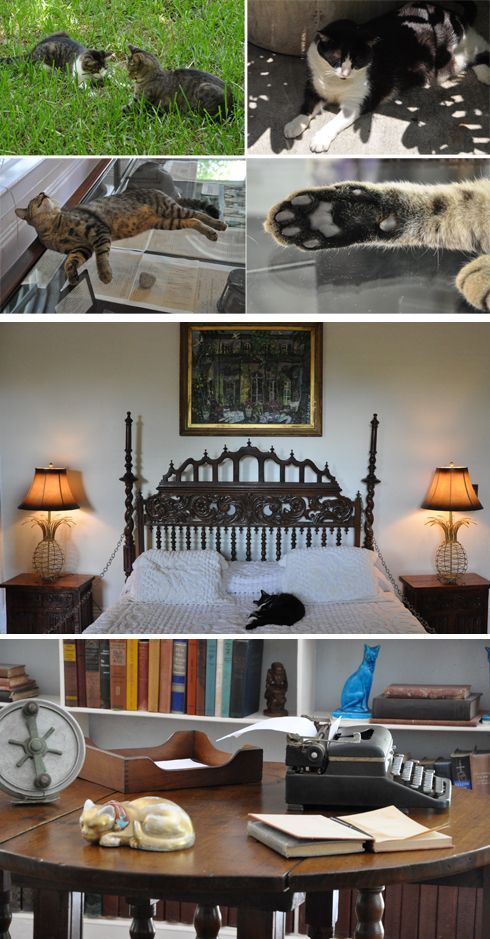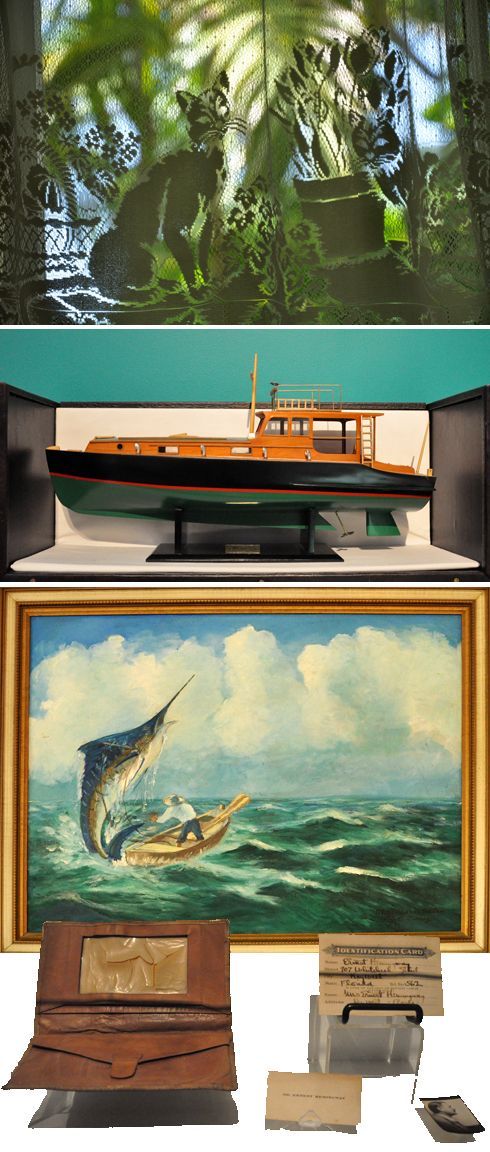Article
Key West: Hemingway Searching for Self
Author(s):
Key West, FL and the literary giant Ernest Hemingway had a shared affection for each other. Today, the city is infused with Hemingway's legacy, making the city a must-see for bibliophiles.
Ernest Hemingway once said:
“There is nothing noble in being superior to your fellow men. True nobility lies in being superior to your former self.”
When Ernest Hemingway used his favorite shotgun to end his life in July 2, 1961 biographer Scott Donaldson quoted the Louisville Courier-Journal editorial: “It is almost as though the Twentieth Century itself has come to a sudden, violent, and premature end.”
Hemingway lived large. Four wives, each discarded it turn when a new infatuation emerged. Enough health disasters for several traveling men: anthrax, amoebic dysentery, a broken arm, concussion, pneumonia. He was badly burned in a bush fire and significantly injured in 2 plane crashes. He suffered alcoholism, diabetes and, of course, depression.
His depression was as much his legacy as his body of writing. When his granddaughter actress supermodel, Margaux Hemingway died almost exactly 35 years later in Santa Monica, her death made her “the fifth person in four generations of her family to commit suicide.”
When Hemingway came off the ferry from Havana in 1928 in Key West, he was already a celebrated author. Says Stuart Newman, a publicist for the Florida Keys, “During his stay Hemingway worked on A Farewell to Arms and became captivated by the island's easygoing ambiance. What he discovered fed his exuberance for living, heralded the beginning of the most prolific period of his career and inspired him to use Depression-era Key West as the locale for To Have and Have Not - his only novel set in the United States.”
Hemingway has long been Key West’s Golden Boy, its greatest, fêted brilliant brat. He changed American literature by his concise minimalistic style, a style favored by punchy intense phrases, a style dramatized subsequently by edgy crime noir novelists. He was a bit of a bully but successful people often are. Tourists learn that Hemingway was special, perhaps more so than a US president, Harry Truman, more so than a playwright, 2-tim Pulitzer Prize winner Tennessee Williams, and maybe more than the man who discovered the largest sunken treasure in the world, Mel Fisher. We will come back to those others in later stories but we are as star-struck as the rest of Key West’s literati, so now we are heading for the Spanish Colonial villa at 907 Whitehead St., the Hemingway House.

The house had a studio and a garage where he kept his Buick. After his death an unpublished manuscript that would become Islands in the Stream was discovered in a vault in the garage. During the Spanish Civil War, when Hemingway was a war correspondent, his second wife, Pauline, spent $20,000 to create the only home swimming pool in Key West. He was angry, not pleased, and tossed a penny on the ground saying she had surely spent his last cent. Pauline had it embedded in the concrete around the pool. It is seen in the insert top left in the third image.
The home is now a US National Historic Landmark. It is easily found just across the street from the Key West Lighthouse which apparently made it easy for Hemingway to find his way home when he had been celebrating life—as he so often did. He lived here until his death In Idaho in 1961. You can feel his presence in this house from his famous 6-toed cats that can be seen everywhere to his portable typewriter which sits on a table in his studio as if he had just risen from it.

Descendants of Hemingway’s polydactyl cats.
Hemingway was once given a 6-toed cat as a gift by a friend, Stanley Dexter, a sea captain. The cat’s descendants, which have at times numbered as many as 40 to 50, all apparently carry the polydactyl trait. The cats have names like Humphrey Bogart, Frank Sinatra, Zsa Zsa Gabor and Marlene Dietrich. To see the whole Who’sWho click here. The cats are well looked after and have their own veterinarian but recently the government has shown an “overreaching” interest in their welfare and believes the cats should be caged. Seemingly the authorities are unaware that when Adlai Stevenson was governor of Illinois he rebuked attempts for the state to a have a “Cat Leash Law” with the valid comment that “lawmakers have enough to do without trying to control feline delinquency.” We recall Adlai Stevenson’s stepping out of a train after losing a presidential election in 1956 and responding to a reporter’s question, “Will you run again?” with “Have that man’s head examined!”

The studio is next door to the house. Previously a (now disused) walkway at the second level led to where he worked in the past.

Hemingway loved his cats but he surely loved other things widely: the challenge of the sea; the lure of deep sea fishing; the pleasure of his 38-foot boat Pilar (named after the heroine in For Whom The Bells Tolls); and even the relationship he had for artists who illustrated his novels. He had a special wallet he kept his fishing license in. And his life is well documented in Key West and easily accessible. He was well respected here, even revered.
Paul Hendrickson, the author of the non-fiction Hemingway’s Boat, Everything He Loved in Life, and Lost, 1934-1961, narrowed the focus for his Hemingway biography to the fishing boat Hemingway bought with an advance of $3,000 that he got from Esquire for some short stories. Hendrickson, a former writer for the Washington Post, says, “Hemingway lovingly owned Pilar, rode her and fished her through three wives, the Nobel Prize and all his ruin.”

Hemingway did not fake it. He was a vigorous, athletic burly man who lived life to the fullest. The image here is from a photograph like many taken at the Old Custom House Museum. It shows Hemingway with his catch in Cojimar, Cuba, May 1933. Catching a big one would be cause for celebration but he never really needed a reason. His favorite bar was the oldest in Florida, Sloppy Joe’s, but that bar moved into larger premises across the street and now Capt. Tony’s Saloon occupies the space once hallowed by Ernest Hemingway.
The Old Custom House Museum has a tribute to Hemingway “Following the Fish: Hemingway in Key West” open until July 8 and sponsored by Marriott Key West Beachside, the Hemingway Home, and the Tropic Cinema. Perhaps those sponsors will be persuaded to prolong the exhibition.

The Custom House’s bronze of Hemingway, the fisherman, was sculpted by Terry Jones in 2005, but it reminds us that Hemingway established a world record in 1938 by catching 7 marlins in one day. The portrait of a young Hemingway at ease hangs in the Hemingway House. His typewriter is photographed courtesy of the Custom House Museum and the illustrations for The Old Man of the Sea by famed Jamaican artist Guy Harvey are shot by us, courtesy of owners Dave and Cheryl Copham.

Perhaps the most poignant of all our Hemingway images are those we took of the uniform he wore as an ambulance driver in the Italian Campaign of World War I when he was aged 18.
He was working as a reporter for the Kansas City Star in France when war broke out. It was 3 years before America entered the war in April 1917 and Hemingway volunteered to drive an ambulance for the American Red Cross. He was transferred to the Italian front and in July 1918 was knocked unconscious by an Austrian mortar shell that killed 2 Italian soldiers standing beside him. He was struck in 5 areas by shrapnel, including his head and lower limb. When he recovered consciousness he famously carried a badly wounded Italian soldier on his back to a first-aid station. He received the Italian Croce di Guerra for his valor. Photographs showing a young Hemingway and the nurse Agnes von Kurowsky, who cared for him when he was wounded, are very moving. He hoped to marry her but she was about 8 years older and it didn’t work out. His personal experience was the basis for his successful novel, A Farewell to Arms. As is said to novice authors: write what you know about.

La Concha is the tallest hotel in Key West and perhaps historically the grandest. Hemingway and Tennessee Williams wrote some of their work there. Key West Historic Memorial Sculpture Garden in Mallory Square has a memorial to Key West’s famous deserving 36 faces. Hemingway is there as indeed Key Wests’ favorite son.
It’s rather sad to read what Tennessee Williams said to After Dark Magazine in August 1971: “Hemingway and I never established a rapport… We didn’t have much to talk about.”
Many celebrities have visited or lived in Key West and sometimes tourists get confused amongst all the celebrities who have left their mark on the town. Sometimes they give the lie to the concept there are no dumb questions. A guide at the Hemingway House was asked recently by a tourist about Hemingway, “Did he die before or after he was president?” The other tourists were still laughing when we arrived.
Photographs by the authors.
The Andersons, who live in San Diego, are the resident travel & cruise columnists for Physician's Money Digest. Nancy is a former nursing educator, Eric a retired MD. The one-time president of the New Hampshire Academy of Family Physicians. Eric is the only physician in the Society of American Travel Writers. He has also written 5 books, the last called The Man Who Cried Orange: Stories from a Doctor's Life.



